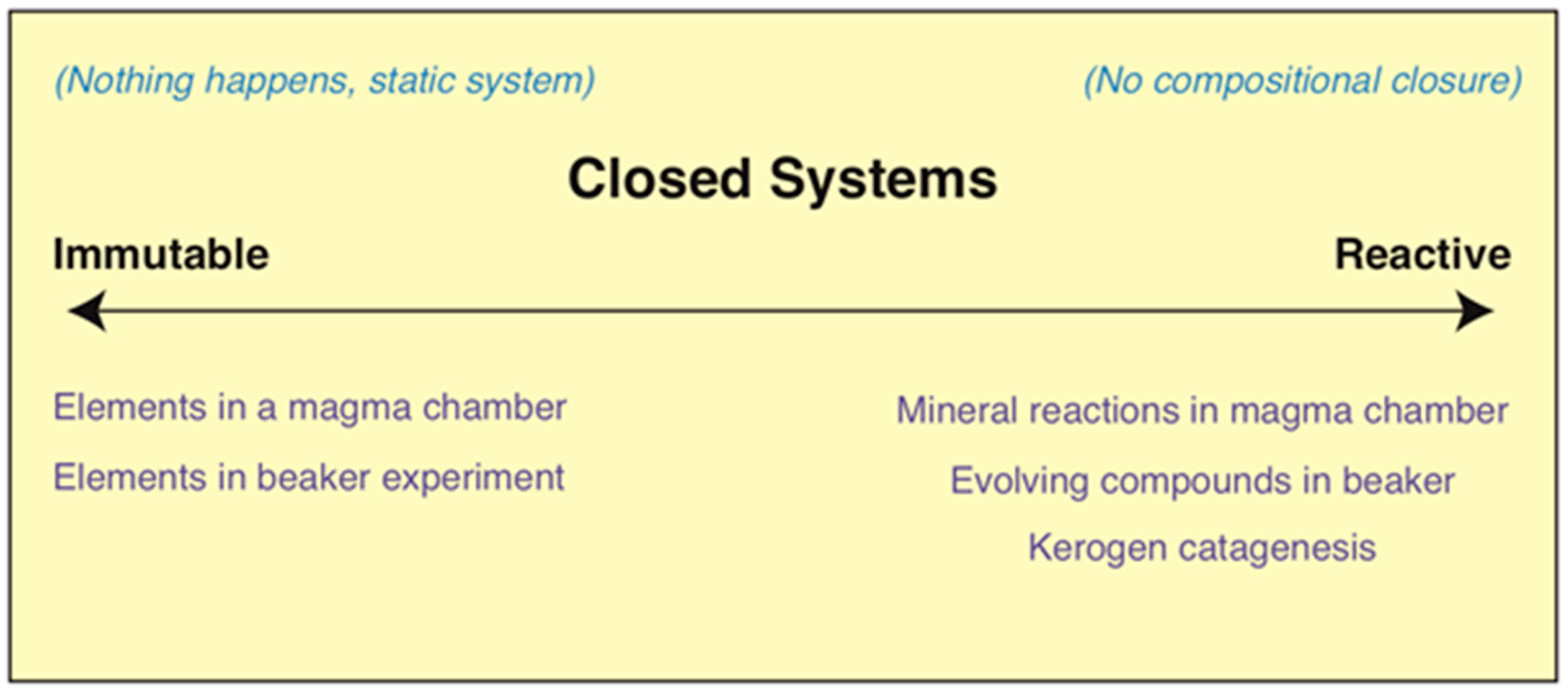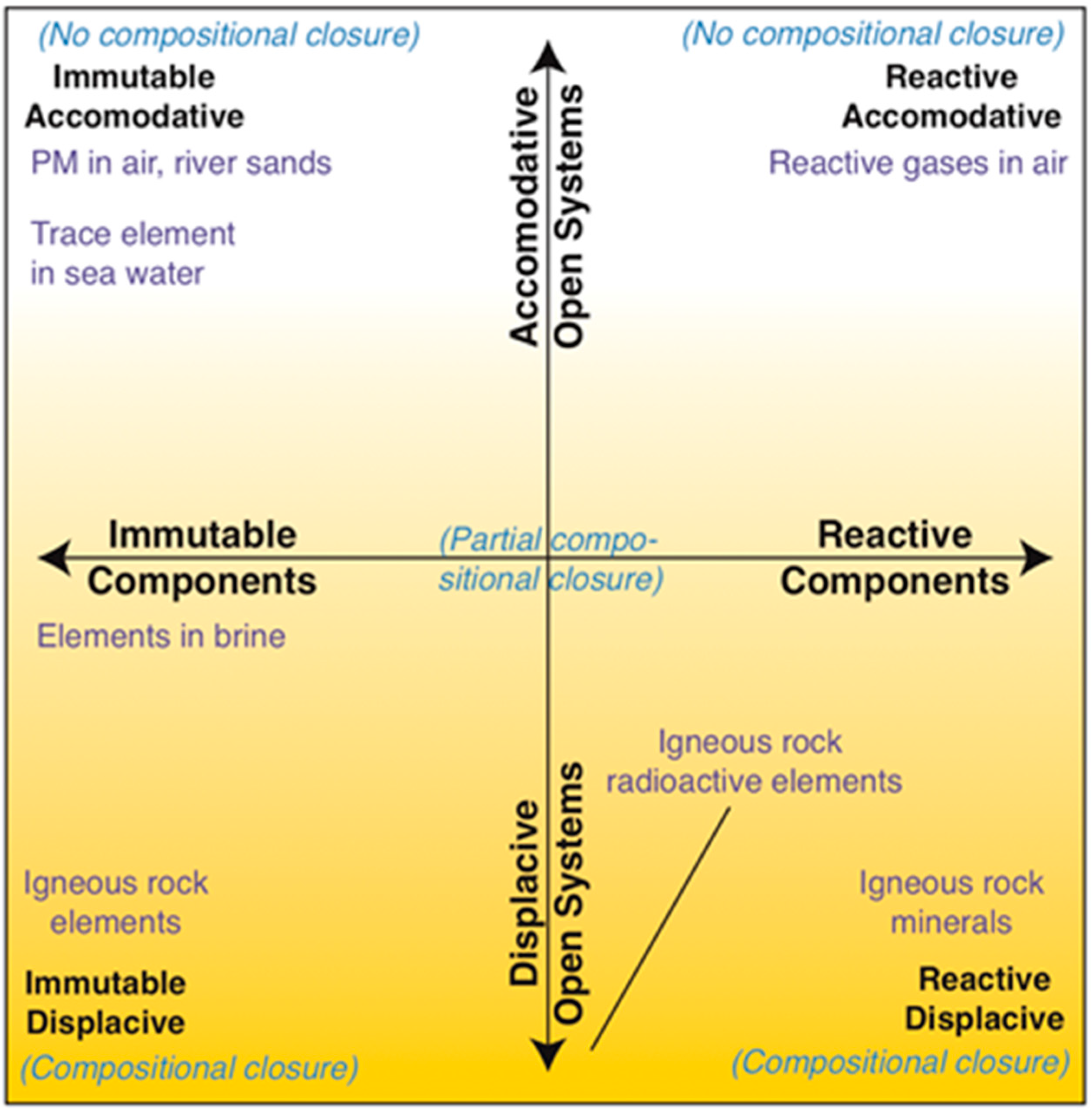5.1. Statistical Closure Implications
It should be clear from our parsing of the various mineralogical, petrological, and geochemical systems that not all compositional data are subject to statistical closure. Specifically, in accommodative open systems, correlations are valid, with r = 0 indicating no correlation between the two tested variables (i.e., the null hypothesis for correlation is a slope of 0). Likewise, such multivariate techniques as principal component analysis can be performed directly from the correlation or covariance matrix, without such manipulations as log-ratios or CoDA. These approaches can still be applied, but results focus on the relative nature of the components and information, and antithetical relationships (e.g., negative correlations) are lost. These findings apply equally to accommodative open systems with either immutable or displacive components.
5.3. Immutable vs. Reactive Displacive Systems
Changes in immutable displacive systems, by their definition, occur only as the result of transfer of components. Thus, slopes in the correlation constituents of an immutable displacive system simply indicate the relative flux of the two items into or out of the basis, which we define as the denominator in the unit of measurement. In contrast, changes in reactive displacive systems can occur by transfer of components, by reactions between components, or by both processes. Thus, interpretation of data from a reactive displacive system is more challenging when trying to determine how much of the change is the result of ingress/egress of components in the basis and how much is the result of reactions between the components. This is an important aspect of the closure problem in mineralogy, petrology, and geochemistry.
One might consider a continuum of situations between the end-member extremes of all displacement due to a reaction between components and all displacement due to ingress–egress of reactive components. Note that the latter is the situation in immutable displacive systems. Thus, we can consider, in effect, a horizontal continuum between the lower left and lower right corners of
Figure 2. Rather than intermediate positions representing the degree of reactivity of the components, such positions would represent the relative proportion of change due to ingress–egress vs. reactions.
Determining the relative roles of reaction and exchange can be a significant problem in such areas as igneous petrology. Petrographic evidence in the mineral suite, e.g., corrosion rims, replacement textures, etc., can provide important clues in this regard.
5.4. The Accommodative–Displacive System Paradox
Many commonly studied mineralogical, petrological, and geochemical systems are not physically displacive in the sense that the “room was full” and someone had to leave for someone new to enter. Further, most such systems (e.g., those in igneous petrology) are sampled in space as a proxy for time. Nonetheless, the geochemical process under study becomes displacive when and because the variables are presented relative to a fixed mass. This is not, of course, mathematics altering nature, but rather the researcher studying a different system.
As an illustration, consider a comparison of the 10 major elemental compositions of, say, a dozen separate plutons. The geochemical approach is to examine the correlation between these elements via an n × N (10 × 12) table. What kind of system is this?
If we consider each pluton as a whole, we are dealing with open accommodative systems. Each pluton reached its current crystallized state after, probably, a number of discrete injections of magma. Thus, these systems were open; addition of new magma and minor loss of material by such processes as gas venting in no way crowded out certain elements at the expense of entering ones. The plutons simply grew larger, accommodating the additions of mass. Inter-elemental correlation coefficients are valid (i.e., r = 0 represents no correlation) if the 10 × 12 data set consists of the total mass of each element in each pluton rather than a concentration. Although an unusual approach, the masses of each element are, in fact, the absolute composition of each pluton. Yes, these are compositional data even though they are not ratios, and thus, even in the traditional view they would not be subject to closure. (These masses might have been estimated or calculated by averaging many conventional samples for each pluton even if those samples initially were measured as mass percent.)
In contrast, if the average composition of each pluton is characterized in mass percent, something striking occurs. The system becomes a displacive one, and compositional closure ensues. A rather “Schrödingerian” turn of events results: our choice of measurement alters the statistical result!
Why? Apparently, sampling a specific mass and reporting results per mass changes the system under study from the whole pluton (an open accommodative system) to a fixed-mass sub-portion of the pluton (an open displacive system). The salient point is that during the evolution of the pluton, magma flux through such a sub-portion acted in a displacive fashion, with added material crowding out occupying components. This system exhibits statistical closure. Such closure is not simply an artifact of the mathematics of ratios, but actually reflects a physical reality—the sampling of a displacive open system.
Expressed slightly differently, the entire pluton is an accommodative open system. Any individual sample of the pluton can be considered a small fixed box, the history of which was a displacive open system. The whole, being of unlimited volume, is accommodative, but the part, being of fixed volume or mass, is displacive. (A minor issue, possible loss of fluids or gasses to the enclosing rock, is not being considered here.)
Viewed another way, the entire pluton encompasses the summation of its evolution. In contrast, any sub-system (a given volume within the pluton) does not retain the information of ingress and egress of material to and from the other volumes in the pluton. Thus, it is not possible to reconstruct this history from mathematical manipulation of its final composition. Following, there is no mathematical function to reverse the effect of closure—it is simply intrinsic.
5.5. Another Example of the Accommodative–Displacive System Paradox
Consider, next, a data set of trace elements in seawater from various locations, expressed as ppm relative to sample mass—water plus dissolved solids (one could also take the data as grams per liter or moles per liter). We have shown that such a system is open accommodative because, physically, the addition of small masses of different elements does not crowd out other elements. The data do not exhibit closure so long as the salinity of the samples remains relatively constant, such that they do not induce displacement. In this case, there can be a difference between results from conventional and compositional data analysis approaches, but that is largely a product of the log scaling in the latter, which moves from an emphasis on linear variance to that of log variance [
7].
If instead we present these data as ppm or percent of each element relative to total dissolved solids, once again closure ensues, as the system under study converts to open displacive. What is the physical meaning? Figuratively and perhaps literally, the water has evaporated. Seawater is no longer being studied; in effect, an evaporite deposit is. The sample now comprises a fixed mass of a part of an evaporite deposit. As such, it is an open displacive system, similar to the pluton sample and characterized, therefore, by compositional closure. However, if there were samples with a different degree of evaporation, the total amount of salt varies as does its relative composition, making for a system of mixed absolute (i.e., total salt content) and relative/compositional data. Point count data are similar in this manner—they can be interpreted either directly as abundance data (which are devoid of closure) or as proportions (controlled by closure). Work by Pawlowsky-Glahn et al. [
8] developed a compositional approach that considers a scenario where both relative and absolute variations are important (i.e., consider the same system from both absolute and relative differences), but it is unclear how the results would vary from systems ranging along the accommodative–displacive continuum. Regardless, the paradox is clear—a single system can be viewed or considered in different aspects, which can change both the nature and interpretation of the results.







